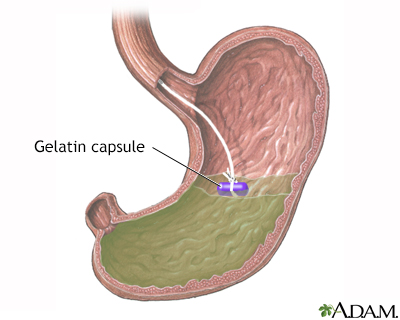String test
Duodenal parasites test; Giardia - string test
A string test involves swallowing a string to obtain a sample from the upper part of the small intestine. The sample is then tested to look for intestinal parasites.
Images


How the Test is Performed
To have this test, you swallow a string with a weighted gelatin capsule on the end. The string is pulled out 4 hours later. Any bile, blood, or mucus attached to the string is examined under the microscope. This is done to look for cells and parasites or parasite eggs.
How to Prepare for the Test
You may be asked not to eat or drink anything for 12 hours before the test.
How the Test will Feel
You may find it hard to swallow the string. You may have an urge to vomit when the string is being removed.
Why the Test is Performed
The test is performed when your health care provider suspects that you have a parasite infection. Usually a stool sample is tested first. A string test may be done if the stool sample is negative but a parasite infection is still suspected.
Normal Results
No blood, parasites, fungi, or abnormal cells is normal.
Normal value ranges may vary slightly among different laboratories. Talk to your provider about the meaning of your test results.
What Abnormal Results Mean
Abnormal results may be a sign of parasite infection, such as giardia.
Considerations
Treatment with certain drugs can affect the test results.
Related Information
Giardia infectionReferences
Adam RD. Giardiasis. In: Ryan ET, Hill DR, Solomon T, Aronson NE, Endy TP, eds. Hunter's Tropical Medicine and Emerging Infectious Diseases. 10th ed. Philadelphia, PA: Elsevier; 2020:chap 95.
Melia JMP, Sears CL. Infectious enteritis and proctocolitis. In: Feldman M, Friedman LS, Brandt LJ, eds. Sleisenger and Fordtran's Gastrointestinal and Liver Disease. 11th ed. Philadelphia, PA: Elsevier; 2021:chap 110.
Siddiqi HA, Rabinowitz S, Axiotis CA.. Laboratory diagnosis of gastrointestinal and pancreatic disorders. In: McPherson RA, Pincus MR, eds. Henry's Clinical Diagnosis and Management by Laboratory Methods. 24th ed. Philadelphia, PA: Elsevier; 2022:chap 23.
Wojewoda CM. Stempak LM. Medical bacteriology. In: McPherson RA, Pincus MR, eds. Henry's Clinical Diagnosis and Management by Laboratory Methods. 24th ed. Philadelphia, PA: Elsevier; 2022:chap 57.
BACK TO TOPReview Date: 5/6/2022
Reviewed By: Michael M. Phillips, MD, Emeritus Professor of Medicine, The George Washington University School of Medicine, Washington, DC. Also reviewed by David C. Dugdale, MD, Medical Director, Brenda Conaway, Editorial Director, and the A.D.A.M. Editorial team.

Health Content Provider
06/01/2025
|
A.D.A.M., Inc. is accredited by URAC, for Health Content Provider (www.urac.org). URAC's accreditation program is an independent audit to verify that A.D.A.M. follows rigorous standards of quality and accountability. A.D.A.M. is among the first to achieve this important distinction for online health information and services. Learn more about A.D.A.M.'s editorial policy, editorial process and privacy policy. A.D.A.M. is also a founding member of Hi-Ethics. This site complied with the HONcode standard for trustworthy health information from 1995 to 2022, after which HON (Health On the Net, a not-for-profit organization that promoted transparent and reliable health information online) was discontinued. |
The information provided herein should not be used during any medical emergency or for the diagnosis or treatment of any medical condition. A licensed medical professional should be consulted for diagnosis and treatment of any and all medical conditions. Links to other sites are provided for information only -- they do not constitute endorsements of those other sites. © 1997- 2024 A.D.A.M., a business unit of Ebix, Inc. Any duplication or distribution of the information contained herein is strictly prohibited.
